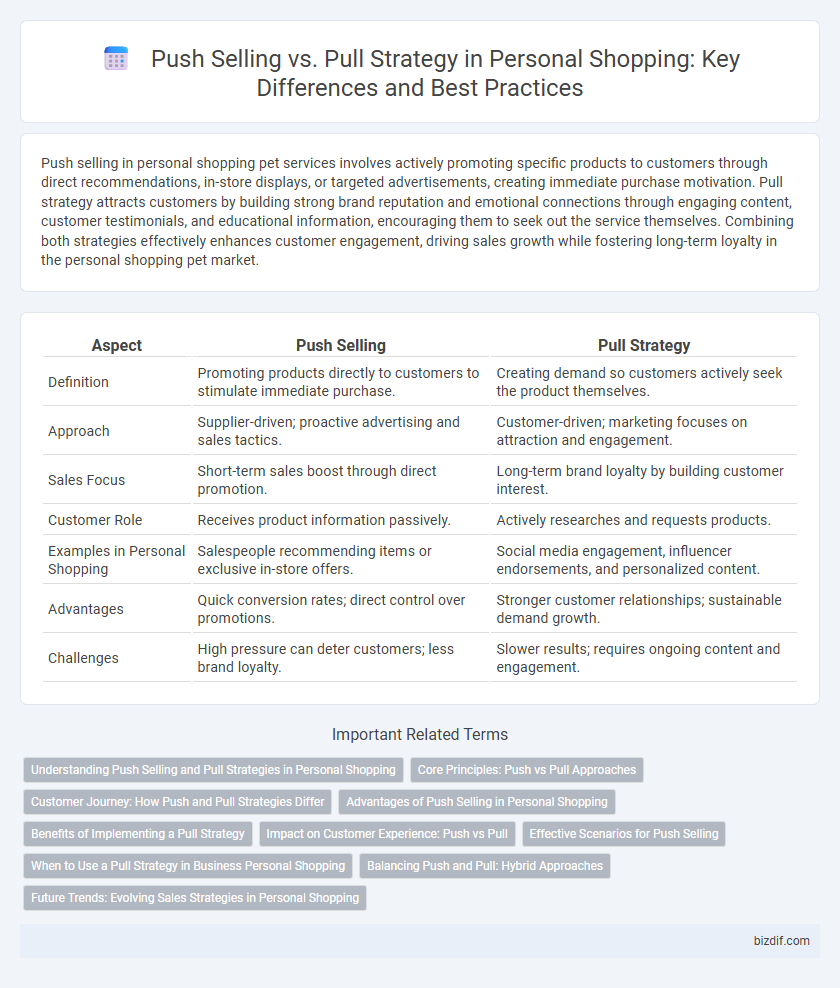Push selling in personal shopping pet services involves actively promoting specific products to customers through direct recommendations, in-store displays, or targeted advertisements, creating immediate purchase motivation. Pull strategy attracts customers by building strong brand reputation and emotional connections through engaging content, customer testimonials, and educational information, encouraging them to seek out the service themselves. Combining both strategies effectively enhances customer engagement, driving sales growth while fostering long-term loyalty in the personal shopping pet market.
Table of Comparison
| Aspect | Push Selling | Pull Strategy |
|---|---|---|
| Definition | Promoting products directly to customers to stimulate immediate purchase. | Creating demand so customers actively seek the product themselves. |
| Approach | Supplier-driven; proactive advertising and sales tactics. | Customer-driven; marketing focuses on attraction and engagement. |
| Sales Focus | Short-term sales boost through direct promotion. | Long-term brand loyalty by building customer interest. |
| Customer Role | Receives product information passively. | Actively researches and requests products. |
| Examples in Personal Shopping | Salespeople recommending items or exclusive in-store offers. | Social media engagement, influencer endorsements, and personalized content. |
| Advantages | Quick conversion rates; direct control over promotions. | Stronger customer relationships; sustainable demand growth. |
| Challenges | High pressure can deter customers; less brand loyalty. | Slower results; requires ongoing content and engagement. |
Understanding Push Selling and Pull Strategies in Personal Shopping
Push selling in personal shopping involves actively promoting products to customers through direct communication, personalized recommendations, and in-store displays to influence immediate purchases. Pull strategy focuses on attracting customers by creating strong brand appeal and demand through social media marketing, influencer partnerships, and engaging content that encourages shoppers to seek out specific products. Combining push and pull strategies maximizes customer engagement and drives both impulse buying and long-term brand loyalty in personal shopping.
Core Principles: Push vs Pull Approaches
Push selling in personal shopping relies on actively promoting products to customers through direct recommendations and persuasive techniques, aiming to create immediate demand. Pull strategy focuses on attracting customers by building brand awareness and providing valuable content that encourages shoppers to seek specific items independently. The core principle distinguishes push as proactive product placement while pull centers on customer-driven interest and engagement.
Customer Journey: How Push and Pull Strategies Differ
Push selling targets customers by proactively promoting products through direct marketing channels, influencing the awareness and consideration stages of the customer journey. Pull strategy attracts customers by creating demand via brand reputation and content marketing, engaging prospects primarily during the interest and decision phases. Understanding these differences helps personalize interactions, optimizing conversion rates and enhancing the overall shopping experience.
Advantages of Push Selling in Personal Shopping
Push selling in personal shopping ensures immediate product availability by proactively promoting items directly to customers, boosting sales velocity and inventory turnover. This strategy enhances customer engagement through personalized recommendations, increasing the likelihood of impulse purchases and higher transaction values. Retailers benefit from improved demand forecasting and reduced marketing costs by targeting specific customer segments with tailored promotions.
Benefits of Implementing a Pull Strategy
Implementing a pull strategy in personal shopping enhances customer engagement by attracting shoppers through targeted content and personalized recommendations, fostering brand loyalty and repeat purchases. This approach reduces inventory risks and lowers marketing costs by responding directly to consumer demand rather than pushing products onto uninterested buyers. Businesses leveraging pull strategies benefit from improved customer satisfaction and higher conversion rates due to a more tailored and responsive shopping experience.
Impact on Customer Experience: Push vs Pull
Push selling often overwhelms customers with aggressive promotions, leading to a less personalized and sometimes intrusive shopping experience. Pull strategy enhances customer experience by attracting shoppers through tailored content and genuine engagement, fostering trust and satisfaction. Personalized recommendations and relevant product discovery driven by pull tactics create a more seamless and enjoyable personal shopping journey.
Effective Scenarios for Push Selling
Push selling thrives in scenarios where immediate product exposure and quick sales are essential, such as during seasonal promotions or product launches. Retail environments with high foot traffic benefit from push tactics that actively present products to customers, encouraging impulse purchases. This strategy proves effective when introducing new items to unfamiliar customers who require direct persuasion to engage with products.
When to Use a Pull Strategy in Business Personal Shopping
A pull strategy in business personal shopping is most effective when customers actively seek personalized products or exclusive offers tailored to their preferences, creating demand through targeted content and personalized experiences. It works best in competitive markets where customer engagement and brand loyalty drive purchasing decisions, leveraging social media, influencer partnerships, and customized recommendations. Employing a pull strategy encourages ongoing client interaction, leading to higher retention rates and increased lifetime value.
Balancing Push and Pull: Hybrid Approaches
Hybrid approaches in personal shopping combine push selling tactics, such as targeted promotions and personalized recommendations, with pull strategies that emphasize customer attraction through engaging content and brand reputation. Balancing push and pull enables retailers to proactively influence purchase decisions while nurturing long-term customer relationships and loyalty. Effective integration of these strategies maximizes customer engagement and sales conversion by leveraging both demand creation and demand fulfillment.
Future Trends: Evolving Sales Strategies in Personal Shopping
Future trends in personal shopping reveal a shift towards pull strategies, leveraging AI-driven insights to attract customers through personalized recommendations and seamless online experiences. Enhanced data analytics enable retailers to anticipate consumer needs, fostering engagement without relying on traditional push selling tactics. The integration of augmented reality and virtual assistants further refines pull approaches, creating immersive and customer-centric shopping journeys.
Push selling vs Pull strategy Infographic

 bizdif.com
bizdif.com